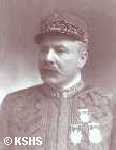|
|
|
|
|
|
|
|
|
| Title | Stars And Stripes Forever, The | |||
|---|---|---|---|---|
| Composer | Sousa, John Philip |
Marshall’s Civic Band Topeka, KS Est’d 1884 |
Number | M-929 |
| Type | CB | |||
| Date | 1897 | |||
| Key | Eb | |||
| Arranger | None |
 |
Length | 0.00 |
| Publisher | Boosey & Hawkes Co. | Vocal | No | |
| Association | Grade/Difficulty | ?/? | ||
| Last Performed | Unknown | |||
| Manuscript | No | |||
| Style | March | Location | Marshall's Band Library | |
| Cataloger | Rick Baker | |||
| Date Cataloged | 09/16/1994 | |||
| Notes |
Incomplete; contains no saxophone or trombone parts. Donated to Marshall's band
by Scott Bradley, director of the Onaga High School band.
Composed in 1896. "With the possible exception of 'The Star Spangled Banner,' no
musical composition has done more to arouse the patriotic spirit of America than
this, John Philip Sousa's most beloved composition. It is sometimes taken to be
the national march of the United States, although it has never officially been
so designated. Symbolic of flag-waving in general, it has been used with
considerable effectiveness to generate patriotic feeling ever since its
introduction in Philadelphia on May 14, 1897, when the staid 'Public Ledger'
reported: '...It is stirring enough to rouse the American eagle from his crag,
and set him to shriek exultantly while he hurls his arrows at the aurora
borealis.'
Aside from this flowery review, the march's reception was only slightly
above average for a new Sousa march. It grew gradually in public acceptance, and
with the advent of the Spanish-American War the nation suddenly needed such
patriotic music. Capitalizing on this situation, Sousa used it with maximum
effect to climax his moving pageant, 'The Trooping of the Colors'.
"'The Stars and Stripes Forever' had found its place in history. There was a
vigorous response wherever it was performed, and audiences began to rise as
though it were the national anthem. This became traditional at Sousa Band
concerts. It was his practice to have the cornets, trumpets, trombones, and
piccolos line up at the front of the stage for the final trio, and this added to
the excitement. Many bands still perform the piece this way.
"With the passing years the march has endeared itself to the American
people. The sight of Sousa conducting his own great band in this most glorious
composition always triggered an emotional response. The piece was expected - and
sometimes openly demanded - at every concert of the Sousa Band. Usually it was
played unanounced as an encore. Many former Sousa Band members have stated that
they could not recall a concert in which it was not played, and that they too
were inspired by looking into the misty eyes of those in the audience. That the
players never tired of it is surely a measure of its greatness.
"Sousa was very emotional in speaking of his own patriotism. When asked why
he composed this march, he would insist that its strains were divinely inspired.
In a Sousa Band program at Willow Grove we find this account:
Someone asked, 'Who influenced you to compose 'Stars and Stripes Forever,'
and before the question was hardly asked, Sousa replied, 'God - and I say this
in all reverence! I was in Europe and I got a cablegram that my manager was
dead. I was in Italy and I wished to get home as soon as possible. I rushed to
Genoa, then to Paris and to England and sailed for America. On board the steamer
as I walked miles up and down the deck, back and forth, a mental band was
playing 'Stars and Stripes Forever.' Day after day as I walked it persisted in
crashing into my very soul. I wrote it on Christmas Day, 1896'" (the text
continues...)
The Works of John Philip Sousa
pgs. 84-89
Paul E. Bierley
Integrity Press
1984
|
|||
|
MCB Home |
Concerts |
Library |
What's New |
History |
Contact Us |
FAQs |
Site Search
© 2002-2025, Marshall's Civic Band, Inc. |